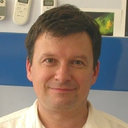Further studies on the cytochemistry of the standardized silver staining of interphase nucleoli in smear preparations of Yoshida ascitic sarcoma cells in rats.
Atslēgvārdi
Abstrakts
Silver staining procedure for the selective demonstration of nucleolar silver stained granules (SSG) and for the simultaneous demonstration of SSG and nucleolar silver stained matrix (SSM) were studied in smears of rat Yoshida sarcoma cells. The successful results of these procedures depend mainly on the quality of silver nitrate and formaldehyde. However, both chemicals can be easily standardized and stabilized disregarding their origin and batch. In standardized procedures (one-step procedure for the selective demonstration of SSG and two-steps procedure for the simultaneous demonstration of SSG and SSM) the silver is apparently bound to acidic groups of proteins of SSG and SSM. The proteins of SSG and SSM seem to be different but both belong to the group of acidic non-histone proteins. According to the results of digestion experiments a possibility also exists that the acidic proteins of SSG may be associated with DNA. The identification of SSG visualized by described standardized procedures was determined not only by cytochemical extraction tests but also by biological experiments. The latter demonstrated that the number of SSG in Yoshida sarcoma cells decreases after treatment of experimental animals with actinomycin D and therefore depends on the state of the nucleolar RNA synthesis.


